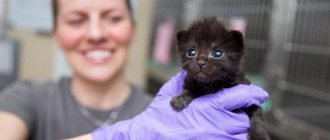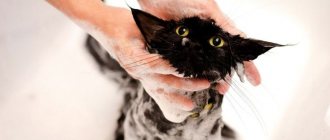(1 votes, rating: 3,00 out of 5)
5589564
07/07/2021 owner reviews 1,
Many owners ask us how many times a cat can become pregnant in a year. Well, if you decide not to spay your cat and she is now pregnant, the only thing you can do is continue the pregnancy, find a safe shelter for the kittens, and then have her spayed once the kittens are weaned.
However, it is important to know that a cat's gestation period is much shorter than that of a human, and this makes her prone to multiple consecutive pregnancies within a year, which can sometimes become a serious problem.
Knowing the stages of your cat's fertile cycle will help you consider spaying before an unexpected pregnancy occurs. Unfortunately, cat overpopulation is a growing problem around the world.
The problem arises not only from unneutered animals roaming the streets, but also from a combination of short gestation periods and large litters. If you love your cat and are unable to care for a litter, neutering should be a priority.
© shutterstock
- How many times a year can a cat give birth?
- How many kittens can a cat give birth to in a year?
- Why is it so important to spay your cat?
How many times a year can a cat give birth?
The age at which a cat reaches sexual maturity varies and depends on genetic and environmental factors. This hormonal change can occur in about 4-10 months, depending on the breed. For example, Siamese cats often come into heat at 4 months, while Persian cats usually do not reach full maturity until almost a year old.
Once your cat reaches sexual maturity, she can go into heat at any time, which usually lasts a little over a week.
A cat can potentially become pregnant again after giving birth to a litter. Mature females appear to go in and out of their "estrus" or heat cycle without a break, once every two or three weeks. The typical mating season for cats runs from about March to fall, although females can become pregnant year-round.
Cats' cycles are also affected by the number of hours of daylight and other natural factors such as temperature. Domestic cats can stay warm all year round. This is due to the fact that they are exposed to artificial light for many hours.
How many times a year do cats give birth? Once pregnant, a cat's gestation period is about 2 months, allowing her to give birth up to 3 times a year .
Necessary preparation
After successful conception, the formation of future kittens begins, which takes 60-65 days. During this time, it is recommended to find a veterinarian who is ready to provide emergency medical care at home in case of complications.
Arrangement of the place
During and after birth, the cat will need a secluded corner. It is better to prepare it in advance. Otherwise, the pet will hide under the sofa, which will prevent free access to her and the kittens. To build and equip a “maternity hospital” you will need:
- Big box. Make sure that it will accommodate not only the new mother, but also her offspring.
- Soft bedding or blanket. Place a disposable baby diaper under them to prevent the cardboard from getting wet.
- Bowls for water and food. You also need to add a tray. After giving birth, the cat should rest and not run to the other end of the house to relieve itself.
The constructed space must be accessible and spacious. Isolate it from possible threats (children, other pets, drafts) by choosing the quietest and most secure room in the house.
What materials, tools and medications may be needed
A week before the onset of a responsible time, prepare an “alarm suitcase”. He must be kept close until contractions begin. The content should be as follows:
- antiseptics and Oxytocin;
- small syringe;
- cotton pads and gloves;
- water container;
- separate box for newborns;
- clean towels or cotton fabrics;
- sterile threads and napkins;
- warmer;
- pipette and rubber bulb;
- scissors disinfected with alcohol;
- dry milk mixture.
All these things should be stored in one place. The number of tools and materials needed depends on the severity of the lambing.
What not to do
Cats usually give birth when it's late afternoon or even night. During this time, the pet should not be left alone. Take care of completing all the tasks in advance and give your pregnant pet maximum attention.
In case of complications, contact your veterinarian immediately. Trying to fix the problem yourself can kill the animal. Also, avoid using Oxytocin until the last minute. This drug is used to stimulate labor strictly in the presence of certain factors. If the process takes too long, but is not accompanied by complications, be patient. The body will cope with the birth of babies on its own at a pace that is convenient for it.
How many kittens can a cat give birth to in a year?
Depending on breed, health, environment and many other external factors, a cat may have a different number of kittens each time she becomes pregnant.
On average, females give birth to 4 kittens per litter. However, this is an average and may not apply to all situations. However, a simple calculation is enough and on average she can have 12 kittens per year .
Most domestic cats tend to live around 12-15 years, so 4 kittens per litter 3 times a year for 15 years results in 180 kittens in a lifetime.
It is completely normal for a healthy, medium-sized adult cat to give birth to 5 kittens in a litter, and then only give birth to 3 kittens in the next litter. Just like in humans, cats' reproductive capacity declines with age. This means that the older the cat, the fewer kittens she will have in her litter.
© shutterstock
How does childbirth take place and how many hours?
In order for your cat to lamb without complications and for all the kittens to be alive and healthy, you need to help your pet.
Every pet owner should provide assistance correctly and efficiently, and know the main stages and features of childbirth.
To cope with childbirth in a cat, it is enough to familiarize yourself with the process using special literature.
If an animal develops complications before or during birth, you should definitely call a veterinarian.
How does childbirth occur in a cat?
- The first stage is determined by the beginning. Contractions can be determined in accordance with the behavior of the animal. The female begins to look for a suitable place, constantly hangs around the owners and becomes noticeably nervous, experiencing painful sensations.
- After the end of the first stage, which lasts from 12 to 24 hours, the time comes for the second. At this moment the attempts begin. The cat no longer moves, the amniotic fluid is leaking. At this moment, it is advisable to stay near the pet for as long as possible.
- The cat does not need help during the birth process. It is enough to accept the kittens and lay them down so that the new mother cannot crush or injure the babies. If the kitten walks not with its head, but with its legs forward, then the animal needs help: slightly pull the kitten by the paw forward, and then down.
Lambing will end in about 1-3 hours. The young mother will begin to lick and feed her offspring. To prevent the animal from getting up again, you need to place food and drink nearby.
For the first 3 days, it is worth closely monitoring the health of the female and the offspring. During this time, problems or pathologies will appear that may affect the further quality of life.
Useful video
Share this post
- Related Posts
- How to learn to play the fool correctly on cards: rules
- The most shade-tolerant and unpretentious indoor plants: names and photos
- How can you remember where you put something long ago?
- How to properly get rid of onion odor from your mouth
- How to descale a kettle with vinegar, citric acid and Coca-Cola, and why does it form?
- Korean surnames for girls and boys: list of popular and beautiful options
Discussion: there is 1 comment
- Motherinstvo.Info:
09/15/2018 at 02:11The article contains all the necessary information for the owner of the animal, supported by a photo in order to learn how to distinguish a cat from a cat. It will also be useful to learn how to properly feed a kitten at 10-12 weeks.
Answer
Why is it so important to spay your cat?
Unless you want to open a kitten breeding business, you need to make sure your precious cat doesn't turn into a breeding machine.
You can avoid contact with any cat unless you want to care for dozens of kittens every year.
However, sterilizing the cat is the best option, although many owners are against it. In fact, sterilization is an act of love. Not only will you have a cat with less mood swings, anxiety and stress due to any heat, but you will also reduce the likelihood of your pet running away from home. Plus, this way you won't have to worry about finding a kitten-safe roof. Irresponsible breeding often leads to the appearance of colonies of feral cats on the street.
Is it possible to influence the number of kittens in a litter?
In ordinary life, owners rarely seek to influence a mother cat in order to increase or decrease the number of future newborn kittens. However, this can be done - primarily with the help of special medications that can stimulate the cat to produce more eggs. Consultation with a specialist is required; any independent intervention can be dangerous for the cat.
The likelihood that a cat will be very fertile also increases if she is given vitamins - selenium and E. However, you cannot select vitamins and their dosage yourself; it is important to entrust this to an experienced specialist. Otherwise, there is a risk of harming the cat’s health, disrupting the functioning of its gastrointestinal tract and more.
Frequency
Almost immediately after the birth of kittens, the female is ready to become pregnant again. Reproductively mature individuals enter and exit the so-called heat cycle (estrus) almost continuously, approximately every 2-3 weeks. This period lasts a little more than 7 days. Once a female comes into heat, she is ready to mate and become pregnant.
Although the traditional mating season for cats lasts from early spring to autumn, they can become pregnant throughout the year, including the winter months.
Regulation of reproduction
Your pet's heat cannot simply be ignored. This leads to the development of pathologies of the reproductive system and negatively affects her mental state. To suppress sexual desire, cats often use hormonal agents: “Cat Bayun”, “Stop-stress”. Such medications contain natural ingredients and calm the cat. But if the owners do not plan to breed animals or see that the pet does not tolerate pregnancy well, then it is better to sterilize it.
Source
What's the norm?
Knowing in advance how many kittens will appear, especially if the birth is the first, is not only a matter of convenience, but also safety for the animal. The owner will be able to prepare to provide assistance if a large offspring is expected. In addition, you can find new homes for the kids in advance, and breeders could calculate the benefits from selling club kittens.
The exact number of kittens is difficult to predict. Conclusions can be drawn based on statistics. Usually 4 to 6 kittens are born. But there have been cases of the birth of more than 10 healthy babies.
Fact! In 1970, the cat Antigone gave birth to 19 kittens. And a mother from South Africa named Bluebell has 14, and they all survived.
Breeders sometimes rely on this method of determining the number of offspring: you need to look at how many nipples the cat has. Subtract 2 from the sum. The resulting figure will be an approximate number. This method is certainly not accurate, but can be adopted.
At the physiological level, the offspring depends on how many fertilized eggs attach to the wall of the uterus. Veterinarians advise checking the offspring with an ultrasound machine a week before birth.
Important! You should not feel the belly of a pregnant cat with your hands. On the one hand, this can lead to stress for the expectant mother, and on the other, it can harm the babies.
Young and old cats give birth to fewer kittens, while middle-aged cats give birth to the maximum number. In addition, pets living in comfort have fewer children than domestic ones. Scientists explain this fact by the need to continue the birth in unfavorable conditions in which not all newborns will be able to survive.
If a record number of babies are born, this often leads to high mortality, especially if this happens in street animals. They appear with a very small body weight, and the mother's milk is often not enough to feed everyone.
How often can you give birth?
A sensitive issue that worries good owners concerns how often a cat can give birth. There are several opinions that differ significantly.
Veterinarians and professional breeders of certain breeds give different recommendations regarding the frequency of lambing.
Fans adhere to completely different norms, dosing cats with hormonal pills at the time of estrus to stop the process.
How often can a cat give birth:
| Who makes the recommendation regarding the issue? | Top advice regarding lambing |
| Experienced cat breeders | It is recommended to breed a female according to the plan. Typically lambing is planned once a year. It is believed that the female’s body is in harmony and the quality of the litter will be much better |
| Experienced hosts | They say that it is enough for a cat to give birth 2 times a year. This will allow you not to overstrain your body and keep it in good shape. Otherwise, the animal begins to get sick often and behave inappropriately. |
| Veterinarians | Catch a cat when it comes into heat. Therefore, births may not be limited to 3-4 in 1 year. If the animal's needs are ignored, health problems may arise, leading to infertility and even death. |
Sterilization
If you are concerned about your pet's possible pregnancy, do not hesitate to sterilize. Typically, this procedure (like castration) is carried out when kittens reach the age of 5-6 months.
Sterilization not only prevents mating and pregnancy, but also prevents health problems associated with bearing young. As experts point out, after surgery in females, the risk of developing breast cancer and uterine infections decreases.
One of the most important benefits of neutering is the ability to reduce the rapidly increasing cat population where you live.
Source
Features of cat physiology
While the cat is feeding the kittens with milk and taking care of them, she has no time to search for adventures; usually young individuals become mothers twice a year. The older the animal becomes, the longer the recovery period and, accordingly, the cat gives birth less often.
When for some reason a cat loses her cubs, the recovery period after birth is delayed or occurs with complications (for example, inflammation of the mammary glands is possible). In this case, you need to consult a doctor. Usually the veterinarian prescribes injections of hormonal drugs, recommends giving less liquid to drink, and applies a medicinal bandage to the cat.
If the kittens are taken from the mother too early, without allowing her to feed the litter, she may again begin to insistently demand mating.
Pedigree representatives of the cat family are allowed to register up to 2 litters per year. Since a period of 8 months is considered optimal for the restoration of the body, 3 litters within two years are normal.
Thus, the correct answer to the question “Until what age do cats give birth?” sounds like this: an animal is capable of producing kittens until its death. However, to avoid pathological births and defective babies, breeders prefer to castrate or sterilize their pets at the age of 6 or 7 years.











